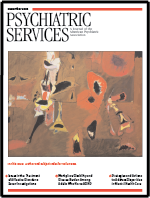To the Editor: Falls of institutionalized patients, particularly elderly patients, can lead to injury, long-term disability, and death. Psychiatric medications have been shown to increase the risk of falling (
1,
2,
3). Quality assurance data at our psychiatric hospital suggested that oxcarbazepine, an antiepileptic used off-label for mood stabilization, particularly increased the risk of falling. We sought to quantify that risk.
The Buffalo Psychiatric Center is a state-operated inpatient hospital that houses 240 psychiatric patients, with an average length of stay of five years. Our analysis was conducted under the authority of a quality improvement program, and our institutional review board did not deem it necessary to review the protocol post hoc. We preserved patient confidentiality by maintaining records on a secure server. The design was a rolling cohort study. The population included all patients who were receiving oxcarbazepine for any duration greater than one day between January 1, 2001, and March 31, 2003. Patients entered the cohort on January 1, 2001, or on their date of admission, whichever came later. They left the cohort on their date of discharge or on March 31, 2003, whichever came earlier. We obtained demographic and medication information from administrative databases. The hospital tracks falls through an incident reporting system.
We calculated falls per 100 patient-days for each patient while the patient was taking the medication and while the patient was not taking the medication; with this method, patients acted as their own controls. We stratified by age to examine potential confounding and sought to strengthen a case for causality by dose stratification.
The cohort included 51 patients—23 men and 28 women—whose mean±SD age was 59.4±16.0 years. Eleven patients were African American, and 40 were white. One patient with a history of head injury, congenital ataxia, and 63 falls was excluded to avoid bias. There were 162 falls and 32,336 patient-days.
The number of falls was significantly higher among patients who were taking oxcarbazepine. Among patients taking the drug the number was .69 falls per 100 patient-days (95 percent confidence interval [CI]=.54 to .84). Among those not taking the drug the number was .38 (CI=.30 to .47). Age stratification showed higher rates for older patients. For patients aged 50 through 65 years (N=20), the rate among those taking the drug was .75 (CI=.52 to .99), and for those not taking the drug it was .46 (CI .32 to .60). For patients over age 65 years (N=17), the corresponding rates were 1.14 (CI =.83 to 1.44) and .43 (CI=.28 to .58). Dose stratification showed a trend toward higher rates at higher doses, although the differences were not statistically significant.
According to the package insert, oxcarbazepine can induce hyponatremia, dizziness, drowsiness, fatigue, abnormal vision, incoordination, and abnormal gait; all these adverse effects might affect the risk of falls.
Strengths of our study included the cohort design, which offers a higher level of evidence than a case-control study, and a relatively long study period. The use of patients as their own controls probably reduced confounding. Weaknesses included the fact that we did not explicitly control for potential confounders, including coexisting neurologic disorders, and used pharmacy records rather than medication administration records, therefore not accounting for medication refusals. The study did not use an outside control group.
Our results indicate that psychiatrists should use caution when prescribing oxcarbazepine for patients who are at risk of falls, especially elderly patients.

